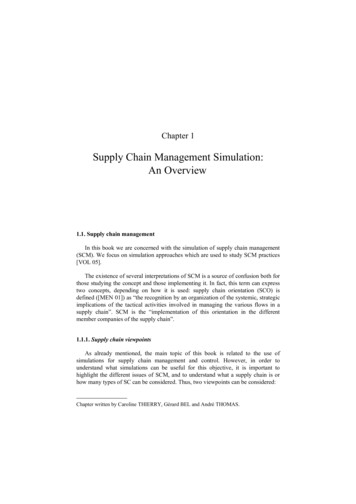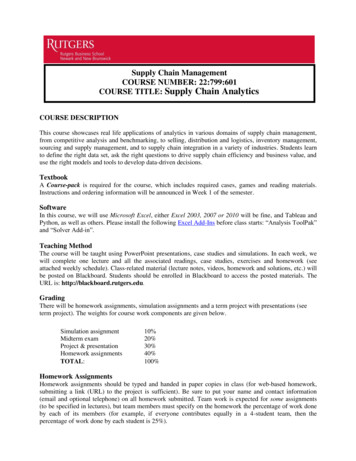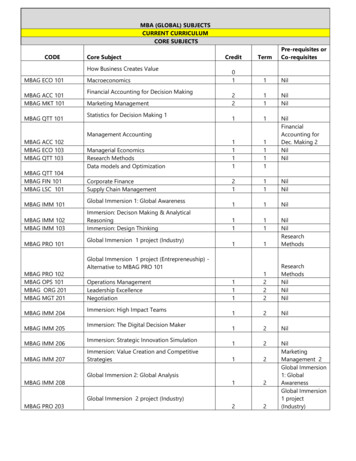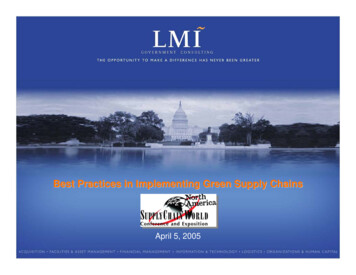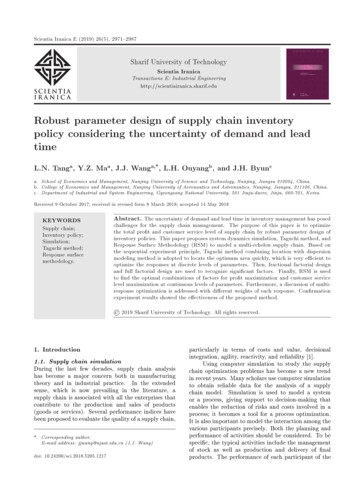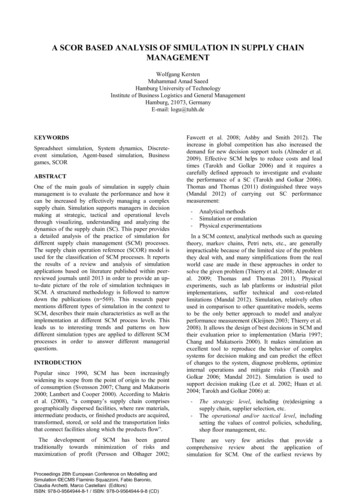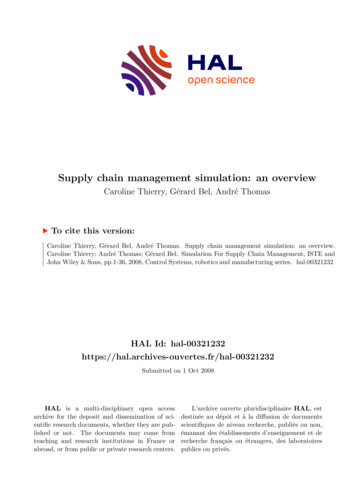
Transcription
Supply chain management simulation: an overviewCaroline Thierry, Gérard Bel, André ThomasTo cite this version:Caroline Thierry, Gérard Bel, André Thomas. Supply chain management simulation: an overview.Caroline Thierry; André Thomas; Gérard Bel. Simulation For Supply Chain Management, ISTE andJohn Wiley & Sons, pp.1-36, 2008, Control Systems, robotics and manufacturing series. hal-00321232 HAL Id: 0321232Submitted on 1 Oct 2008HAL is a multi-disciplinary open accessarchive for the deposit and dissemination of scientific research documents, whether they are published or not. The documents may come fromteaching and research institutions in France orabroad, or from public or private research centers.L’archive ouverte pluridisciplinaire HAL, estdestinée au dépôt et à la diffusion de documentsscientifiques de niveau recherche, publiés ou non,émanant des établissements d’enseignement et derecherche français ou étrangers, des laboratoirespublics ou privés.
Chapter 1Simulation for supply Chain management:An OverviewC. THIERRY, A. THOMAS, G. BEL1.1. Supply chain managementIn this book we are concerned with the simulation for Supply ChainManagement (SCM): we focus on simulation approaches which are used to study theSCM practices [VOL 05].The existence of several interpretation of SCM is a source of confusion both forthose studying the concept and those implementing it. Indeed this term canexpressed two concepts, depending on how it is used: Supply chain Orientation(SCO), is defined ([MEN 01]) as “the recognition by an organisation of thesystemic, strategic implications of the tactical activities involved in managing thevarious flows in a supply chain”. Supply Chain Management is the “implementationof this orientation in the different member companies of the Supply Chain”.1.1.1. Supply chain viewpointsAs said before, the main topic of this book is relative to simulation use forSupply Chain Management and Control. But to understand in what simulation canbe useful for this objective, it is important to highlight the different issues of SCM,and to understand what a supply chain is or how many kind of SC can beconsidered. Thus, two viewpoints can be considered:
2Titre de l’ouvrage– the system under study is the supply chain of a given enterprise, and we canconsider:– the internal supply chain of an enterprise which focus on functionalactivities and processes and on material and information flows within theenterprise. In this case supply chain management may be viewed as theintegration of previously separate operations within a business enterprise.– the external supply chain of the enterprise which includes the enterprise,the suppliers of the company and the suppliers’ suppliers, the customers of thecompany and the customers’ customers (SCOR). In this case supply chainmanagement mainly focuses on integration of operation and cooperation betweenthe enterprise and the other actors of the supply chain.– the supply chain under study is a network of enterprises (without a focus onone particular enterprise of the supply chain): a supply chain is a “network oforganisations that are involved, through upstream and downstream linkages, in thedifferent processes and activities that produce value in the form of products andservices in the hands of the ultimate consumer.” ([CHR 92]). In this viewpoint, thefocus is on the virtual and global nature of business relationships betweenenterprises. In this case supply chain management mainly focuses on cooperationbetween the supply chain actors.1.1.2. Supply chain management1.1.2.1. Supply chain processes: the integrated supply chain point of viewTo describe supply chains with a process point of view, we refer to the SupplyChain Operations Reference (SCOR) model. SCOR is a cross-industry standard forsupply chain management and has been developed and endorsed by the SupplyChain Council (SCC). SCOR focuses on a given company and is based on fivedistinct management processes: Plan, Source, Make, Deliver, and Return.Figure 1.1. The SCOR processes ([SCO 05])
Titre du chapitre3Supply chain management addresses different types of problems according to theconcerned decision horizon. Long range (strategic) decisions are concerned withsupply chain configuration: number and location of suppliers, production facilities,distribution centres, warehouses and customers, etc. Medium and short ranges(tactical and operational) are concerned with decisions material management:inventory management, planning processes, forecasting processes, etc.On the other hand information management is also a key parameter of supplychain management: integrating systems and processes through the supply chain toshare valuable information, including demand signals, forecasts, inventory andtransportation etc.Figure 1.2. which is adapted from the SSCP-Matrix [STA 00] synthesises thedifferent supply chain decision processes:SupplynetworkdesignSuppliers urchasingquantitiesInventory esignDistributionnetworkdesignPlant locationDistribution structureSales tybookingInventory levelMaterialMasterrequirement schedulingLot sizeDeliverLot sizeCapacitybookingInventory ies andmodesProduction Transportscheduling schedulingStart and finishdelivery datesStart and finishdates for eachoperationStart and finishtransportationdatesOrderingmaterialsShop tand ATPFigure 1.2. Different supply chain decision processes (1 organisational unit)CUSTOMERSLongtermMakeSales forecasting and demandplanningSource
4Titre de l’ouvrageSupply chain management deals with the integration of organizational units.Thus the different supply chain processes will be more or less distributed accordingto the level of integration of the different processes.1.1.2.2. Dynamic behaviour of supply chain management systemThere is a process which organise the decisions at different level in the supplychain management system. This system (virtual world) is connected to theproduction system (real world) in order to compose a “closed loop” dynamic system.SupplynetworkdesignSuppliers urchasingquantitiesInventory levelPurchaseschedulingEnd ofprocessingTime on ionnetworkdesignPlant locationDistribution structureSales tybookingInventory levelMaterialMasterrequirement schedulingLot sizeDeliverLot sizeCapacitybookingInventory ies andmodesProduction Transportscheduling schedulingStart and finishdelivery datesStart and finishdates for eachoperationStart and finishtransportationdatesOrderingmaterialsShop floorcontrolWarehousereplenishmentParts locationDemandfulfillmentand ATPCUSTOMERSLongtermMakeSales forecasting and demandplanningSourceInventory levelScheduled receipts(End of planningperiod)Inventory levelScheduled receipts(End of planningperiod)Material flowFigure 1.3. Dynamic behaviour of supply chain management system
Titre du chapitre51.1.2.3. Supply chain processes: the collaborative supply chain point of viewLet’s now consider (figure 1.4) at least two independent organizational units(legal PurchasingquantitiesInventory levelLot sizeShorttermPlant locationDistribution structureSales tybookingInventory levelMaterialMasterrequirement workdesignLot sizeCapacitybookingInventory levelDistributionPlanningSaleStart and finishdelivery datesStart and finishdates for eachoperationStart and finishtransportationdatesOrderingmaterialsShop ignSuppliers Inventory levelDemandfulfillmentand esignDistributionnetworkdesignPlant locationDistribution structureSales &OperationPlanningCapacitybookingInventory levelMaterialMasterrequirement schedulingLot sizeTransportationquantities andmodesProduction Transportscheduling schedulingSourceLot tory levelDistributionPlanningSaleCUSTOMERSSuppliers selectionMakeProductionnetworkdesignSales forecasting and demandplanningSupplynetworkdesignSales forecasting and es andmodesProduction Transportscheduling schedulingStart and finishdelivery datesStart and finishdates for eachoperationStart and finishtransportationdatesOrderingmaterialsShop tand ATPMaterial flowFigure 1.4. Different supply chain decision processes (2 independent units))In this collaborative supply chain, as far as a supplier-buyer partnership isestablished, several problems arise:– how to exchange/share information?– is it possible to perform mutual problem solving?– how to set up global supply chains indicators? Thus the problem of the centralisation or distribution of the information anddecision processes within the supply chain becomes a main challenge for the supplychain managers.
6Titre de l’ouvrage1.2. Simulation for Supply Chain Management1.2.1. Why to use simulation for Supply Chain Management?As far as simulation is concerned the objective is to evaluate the supply chainperformances. We distinguish tree ways to conduct Supply Chain performancemeasurement: analytical methods, such as queuing theory, Monte-Carlo methods, such as simulation or emulation, physical experimentations, such as lab platforms or industrial pilotimplementations.In this context of Supply Chain, analytical methods are impractical because themathematical model corresponding to a realistic case is often too complex to besolved. Obviously, physical experimentations suffer from technical- and cost-relatedlimitations. Simulation seems the only recourse to model and analyse performancesfor such large-scale cases. Simulation enables, on the one hand, the design of thesupply chain and on the other hand, the evaluation of supply chain managementprior to implementation of the system to perform what-if analysis leading to the“best” decision. This simulation includes supply chain flows simulation and decisionprocess dynamics. In the field of supply chain management, simulation can be usedto support supply chain design decisions or evaluation of supply chain policies. Asfar as supply chain design decisions are concerned, the following decisions can beconsidered:– Localisation- Location of facilities- Supply and distribution channel configuration- Location of stocks– Selection- Suppliers- Partner– Size- Capacity booking- Stock level As far as evaluation of supply chain control policies are concerned, the followingdecisions can be considered:– Control policies- Inventory management, control policies- Planning processes– Collaboration policies
Titre du chapitre7- Cooperation/collaboration/coordination - Information sharing 1.2.2. How to use simulation for Supply Chain Management?To attempt to specify the different ways to use simulation for SCM it isimportant to differentiate, on the one hand, the real system (the “real world”) and onthe other, its simulation model.In fact, the simulation model must be built according to its usage and/or the SCMfunction that we want to model or to evaluate. Different classes of models can behighlighted to understand the variety of SC simulation models according to:– the systemic decomposition of the SCM system- Decision system- Information system- Physical systemDecision system(Hierarchical Planning andcontrol process)DecisionReal stateInformation systemDecisionReal statePhysical system(parts, resources, )Figure 1.5. Systemic decomposition of the SCM system– the level of distribution of the system:- simulation model for centralized SCM system evaluationA centralised SCM system consists in a single information and decision system forthe different entities of the supply chain under study.- simulation model for distributed SCM system evaluationA distributed SCM system consists in a distribution of the decision systemover different entities of the supply chain under study.As a matter of fact, the execution of the simulation can be performed:In a centralised way on a single computer
8Titre de l’ouvrage-In a decentralised way:- on multiprocessor computing platforms : parallel simulation- or on geographically distributed computers interconnected via a network,local or wide: distributed simulation.As far as decentralisation of the simulation is concerned, “the execution of asingle main simulation model, made up by several sub-simulation models, which areexecuted, in a distributed manner, over multiple computing stations”. [TER 04]The need of a distributed execution of a simulation across multiple computersderives from four main reasons [TER 04]:– to reduce execution simulation time [ ]– to reproduce a system geographic distribution [ ]– to integrate different simulation models that already exist and to integratedifferent simulation tools and languages [ ]– to increase tolerance to simulation failures [ ]”– to test independently different control models– to progressively deploy a control system,– to prepare at SC control changes”More over it is important to stress that simulation mostly focuses on thedynamics of the supply chain processes concerning both physical and decisionsystems (i.e. production management systems see §1.3.1.).1.3. Supply chain management simulation typesThis section is dedicated to the presentation of the different types of models andapproaches mainly used for supply chain management simulation.As seen before, an important part of the model is the decision system model(hierarchical planning and control processes). So the first subsection presents themain production management models which are used in supply chain management.Then, the different kinds of well known simulation models will be quicklypresented. For each of them we will highlight how the different productionmanagement models can be linked with the simulation model.1.3.1. Production management models focusThe objective of this part is to focus and to present a very synthetic andsimplified description of production management models in order to introduce, in afollowing part, how they can be integrated in a supply chain simulation model. Here
Titre du chapitre9we focus only on the production processes even the approach could be extended tosupply and distribution processes.There are two main categories of production management models.1.3.1.1 Time bucket modelsIn production planning and control, and mainly for long and middle term, we areconcerned with the determination of quantities to be produced per time period for agiven horizon in order to satisfy demand or/and forecast. To perform these decisionprocesses, time bucket models are needed. They are characterized by:– Decision variables: produced, stocked or transported quantities– Data: capacities of the resources (in number of parts per period, for example)– Constraints: conservation of flow, bill of materials, limited capacities, demandsatisfaction Example:For a production line composed of two production resources (see figure 1.6.).input inventory ouput inventoryIiR1,tIoR1,tinput inventoryouput R1,t)R1Production(xR1, t)Stock(yR2,t)R2ProductionStock(xR2,t)Figure 1.6. Time bucket model (example)The demand is dt and the production resources capacities are CR1,t, CR2,t. Eachitem is produced from one single component.The planning model variables are:- xRi,t quantity of items to be produced on resource Ri during time period t- yRi,t quantity of items to be transported from resource Ri during timeperiod t- IiRi,t input inventory level on resource Ri at the beginning of time period t.- IoRi,t output inventory level on resource Ri at the beginning of time period t.The planning model constraints are:- Ii R1,t 1 IiR1,t - x R1,t- IoR1,t 1 IoR1,t x R1,t - yR1,t
10Titre de l’ouvrage- Ii R2,t 1 IiR2,t - x R2,t yR1,t- IoR2,t 1 IoR2,t xR2,t – yR2,t- y R2,t d t- xR1,t CR1,t- xR2,t CR2,t- Ii R1, t0 - IiR, t O R {R1, R2}, t- IoR, t O R {R1, R2}, t- xR,t 0 R {R1, R2}, t- yR, t 0 R {R1, R2}, tJoint to these models, methods are used to perform the plan: MRP like methods,mathematical programming, constraints programming, meta-heuristics.1.3.1.2. Starting time modelsIn production planning and control, and mainly for short term, we are alsoconcerned with the determination of the starting time of tasks on different resources.For that we use starting time models (sequence of timed events). These models arecharacterised by:– Decision variables: starting time of tasks (ti)– Data: ready dates (ri,) due dates (di)– Constraints: precedence, resource sharing, due datesExample:- ti ri- ti tj pj OR tj ti pi- ti pi diJoint to these models, methods are used to perform the schedule: mathematicalprogramming, constraints programming, meta-heuristics 1.3.2Simulation typesDue to the special characteristics of supply chains, the supply chain simulationmodel building is difficult. The two main difficulties are highlighted, and then thedifferent types of models for supply chain management simulation are quicklypresented.
Titre du chapitre111.3.2.1. Size of the systemOne characteristics of supply chain simulation is the huge number of “objects” tobe modelled. A supply chain is composed of a set of companies, composed of a setof factories and warehouses, composed of a set of production resources and stocks.Between all these production resources circulate a set of components, parts,assembled parts, sub-assemblies and final products. So the number of “objects” ofthe model can be very large.1.3.2.2. Complexity of the production management systemTo simulate a system it is necessary to simulate the behaviour of the “physical”system and the behaviour of the “control” system. For a supply chain this implicatesthat it is necessary to model the behaviour of the supply chain management systemof each company and the relation between these production management systems(cooperation).As this supply chain management system is very complex, it can be difficult tomodel it in details. However it is absolutely necessary to model it, as it is this systemwhich controls the product flow in the supply chain. So, according to objective ofthe simulation study and the kind of chosen model, various aggregated or simplifiedmodels of the production management system must be designed. Following sectionspresent different examples of these models.1.3.2.3. Different kinds of models for supply chain management simulation1.3.2.3.1 Simulation modelA simulation model is composed of a set of “objects” and relations betweenthese objects; for example: in a supply chain main objects are items (or set of items)and resources (or set of resources).Each object is characterised by a set of “attributes”. Some attributes have a fixedvalue (example: name) others have a value which varies during the time (example:position of an item in a factory).The state of an object at a given time is the value of all its attributes. The state ofa system at a given time is the set of the attributes of the objects included in thesystem.The purpose of a simulation model is to represent the dynamic behaviour of thesystem.There are various modelling approaches according to how state variations areconsidered:- States vary continuously: continuous approach- States vary at a special time (event): discrete event approach.
12Titre de l’ouvrageThe following parts of this section will introduce the chapters 2 to 4 which willgo into details on the viewpoint and present related works (State of art and recentworks).1.3.3. Simulation of supply chain management using continuous simulationapproachIn this section we will introduce system dynamics, a continuous simulationapproach where states vary continuously. Chapter 2 will go into details and presentrecent works related to this viewpoint of simulation for supply chain management.1.3.3.1. System dynamicsThis new paradigm has been first proposed by Forester for studying “IndustrialDynamics”.Companies are seen as complex systems with [KLE 05] :– different types of flows: manpower, technology, money, and market flows.– stocks or levels which are integrated into time according to the flowvariationsSystem dynamics is centred on the dynamics behaviour. It is a flow model whereit is not possible to differentiate individual entities (like transport resources).Management control is performed by making variations on rates (productionrates, sale rates, ). Control of rates can be viewed as a strong abstraction ofcommon production management rules.The model takes into account the “closed loop effect”: the manager is supposedto compare continuously the value of performance indicator to a target value. In caseof deviation he implements corrective actions.Example:- It2 It1 p(xr t1,t2 – drt1,t2)- xr t1,t2 production rate between two dates t1 and t2- dr t1,t2 sale rate between two dates t1 and t2- p time duration between t1 and t21.3.3.2. Production management models/ simulation modelsThe two models do not consider the same objects states.– In systems dynamics objects are continuous flows. The behaviour of theseflows are represented by a differential equation (with derivate) which is integratedusing a time sampling approach.– In planning models the objects are resources and their activities. It isconsidered that the attributes of these activities change only at a special periodicdates. There is no notion of derivate.
Titre du chapitre13This kind of model seems well adapted to supply chain simulation as it has beendesign by Forester for “Industrial Dynamics” studies which used same concepts asthose used lately in supply chain studies.1.3.4. Simulation of supply chain management using discrete event approachIn this section we will detail the discrete event approach. We will distinguishbetween time bucket driven approach and even driven approach. This differentiationis based on the time advance procedures which characterized these two approaches.Chapter 3 will go into details and present recent works related to this viewpoint ofsimulation for supply chain management.For the “discrete event approach” they are:– different ways to “see the world”: activities, event and processeventactivitytimeprocessFigure 1.7. Events, activities, processes– different procedures to make the time advance in the simulation:- event driveneventeventeventeventtimeFigure 1.8. Event driven discrete events simulation- time bucket driven
14Titre de l’ouvrageeventeventActivityTime bucketTime bucketTime buckettimeFigure 1.9. Time bucket driven discrete events simulationThe main practices to “mix” various types of models and time advanceprocedures are listed below:continuousactivitieseventsprocessTime bucketdrivenXXxxEvent drivenNot possiblewith theapproachxXXFigure 1.10. Discrete events simulation1.3.4.1. Time bucket driven approachDiscrete events simulation using time bucket driven approach is rarely used forjob shop simulation but it well fits for simulation of supply chain management (seethe specific characteristics of this simulation in §1.3.2.1 and §1.3.2.2).1.3.4.1.1. Time bucket driven discrete events modelsIn such a model:– time is divided in periods of a given length: time bucket– time is incremented step by step with a given time bucket. At the end of eachstep a new state is calculated using the model equations. So in this approach it canbe considered that events (corresponding to a change of the state) occur at eachbeginning of a period– the lead time for an item on a production resource is considered smallcompared to the size of the time bucket– the main states are the states of resources (or set of resources) during a givenperiod: they describes the activities in which resources are implicated in a given
Titre du chapitre15time period. They are characterised by the quantities of items processed in thisactivity in a given time period: for example the number of items of a given typemanufactured, stocked or transported by a given resource in a given period.– the simulation has to determine all the states of all the resource at each periodof a simulation run.This kind of model is also called “Spreadsheet simulation” [KLE 05]. We don’tadopt this designation because spreadsheet is a tool with which it is possible to useall the modelling approach.1.3.4.1.2. Simulation modelsIt must be noticed that the planning models presented in § 1.3.1 are also timebucket models which are well known and used in production management domain.We will see hereafter that they are very similar to time bucket driven discrete eventssimulation models but that they are used in a different way in simulation.In order to illustrate that, we consider a very simple example of a production linecomposed of two production resources with no specific production management.Shop floor control is a first-in first-out strategy, k is the number of parts from M1 tobe used to produce one part on M2.Shop floor controlTransportationM1input Productionouputinventoryinventory(xR1, 2,t)IiR2,touputinventoryIR2,tFigure 1.11. Production management models/ simulation models (example)The simulation model uses the following state variables:- IiRi,tis the input inventory level of resource Ri at the beginning of timeperiod t.- IoRi,tis the output inventory level of resource Ri at the beginning of timeperiod t.
16Titre de l’ouvrage-xRi,t is the quantity of part produced by resource Ri during the time buckett (available at the end of t)- yRi,t is the quantity of parts transported from Ri during time bucket t(available at the end of t)The model of the dynamic behaviour of the system is the following:- Ii R1,t 1 IiR1,t - x R1,t- IoR1,t 1 IoR1,t x R1,t - yR1,t- Ii R2,t 1 IiR2,t - x R2,t yR1,t- IoR2,t 1 IoR2,t xR2,t - yR2,t- xR1,t CR1,t- xR2,t CR2,tIt can be noticed immediately that this model is very similar to the productionmanagement model presented in § 1.3.1.1.In order to illustrate that, let’s consider a simulation with this modelcorresponding to the following hypothesis: resource R1 sends parts to resource R2according to a production and transportation plan determined outside of the system.So IiR1,t0, IiR2,t0, xR1,t,, xR2,t, yR1,t, yR2,tare known at the beginning of the simulation.In this case, the true state variables of the model are IiR1,t, IiR2,t , IoR1,t, and IoR2,t.The simulation must determine the variation over time of this variables takinginto account the values of the exogenous variables (xR1,t,, xR2,t, yR1,t, yR2,t). Thussimulation allows evaluation of the proposed production and transportation plan. Itis also possible to introduce hazard in the behaviour of the model.x R1,t xy R1,tR2,tyR2,tIiR1,t0SimulationIo Ri,tIi Ri,tAléasPerturbationsFigure 1.12. Simulation processThis shows that the same model can be used in a:– simulation decision process: taking into account xR1,t xM2,t, yR1,t and yR2,t. theproblem is to determine IiR1,t, IiR2,t , IoR1,t, and IoR2,.– production planning decision process: in a centralised planning (APS or SCMlike) the problem is to determine xRi,t and yRi,t which satisfy the constraints of theplanning model (stock capacity, supplier demand ).
Titre du chapitre17Notice: it is possible to use a “what if” approach with the planning model testingdifferent demands or different production management policies. In this “what if”approach the problem is solved several times, each time with this different data.Then it is possible to see the influence of these data on the generated plan. Thisapproach is not considered in this book: we refer to simulation only when thedynamics of the system is considered.1.3.4.1.3. Production management models/ simulation modelsNow the question is: how the different production management models can belinked to a discrete events simulation model with time bucket approach?Time bucket production planning model can be easily linked to the globalsimulation model as the modelling approach is the same. In this case the two modelswill be joined up: the simulation model focuses on the circulation of the flow ofparts, the planning model determines the quantities to be produced. The Chapter 3provides a study of both discrete events and time bucket simulation used for supplychain management and proposes case studies to illustrate the pivotal role thatsimulation can play as a technique for decision aid.If we consider now the other category of production management models that wecall in § 1.3.1.2 “starting time models” (scheduling, ) we can state that:-“time bucket driven discrete events simulation models” do not use thesame “objects states” than “starting time production management models”(which use “start time of an activity”).-between two periods the bucket driven activities simulation model doesnot represent the state of the system. So the start time of an activity is notknown and cannot be used as data in a “starting time” scheduling model.The only way to obtain a good approximation of this date can be to use avery small time period. But this is often not possible because this willcontradict the fundamental hypothesis for this kind of model: theproduction duration for an item on a production resource is very less thanthe time bucket of the model.1.3.4.2. Event driven approachIn this sub-section the main characteristics of the discrete events models forsupply chain management simulation using event driven approach is presented.Rememb
for such large-scale cases. Simulation enables, on the one hand, the design of the supply chain and on the other hand, the evaluation of supply chain management prior to implementation of the system to perform what-if analysis leading to the "best" decision. This simulation includes supply chain flows simulation and decision process dynamics.


